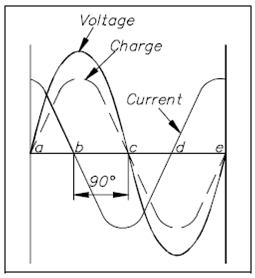Capacitors:
The difference of an alternating voltage applied to a capacitor, a charge on the capacitor, and the current flowing through the capacitor are represented through Figure.
The current flow in a circuit holding capacitance depends on the rate at that the voltage changes. A current flow in Figure is greatest at points a, c, and e. At this point of case, the voltage is changing at its maximum rate that is passing by zero. Among points a and b, the voltage and charge are increasing, and the current flow is into the capacitor, but decreasing in value. At point b, the capacitor is fully charged, and the current is zero. To point's b to c, the voltage and charge are decreasing as the capacitor discharges, and its current flows in a direction opposite to the voltage. From points c to d, the capacitor starts to charge in the opposite direction and the voltage and current are again in the similar direction.

Figure: Voltage, Charge, and Current in a Capacitor
At point d, the capacitor is fully charged, and the current flow is again zero. From points d to e, the capacitor discharges and the flow of current is opposite to the voltage. Given figure describe the current leading the applied voltage by 90°. Much purely capacitive circuit, current leads applied voltage through 90°.